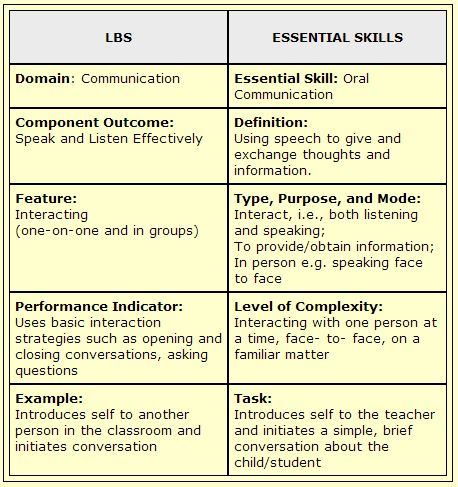While this is not an articulated comparison, the following chart was crafted by Community Literacy of Ontario to illustrate how the Essential Skills may be more familiar than you think. Again, the references for the LBS column were taken from page 45 of the LDM.

By providing opportunities for the student in your agency to practice using “basic interaction strategies,” you would actually be encouraging the use of the Essential Skill of Oral Communication. If proficiency in “opening and closing a conversation, asking questions” is demonstrated, then the learner is ready to take it to the next level, where the demands of the task pose a greater challenge. For example, the more difficult task may demand answering questions where prior knowledge is required. With each successful completion, the learner in your program is building on the ES that will pave the way to successfully managing increasingly complex tasks.
While the ES definitions that are presented in the Readers’ Guide are considered the “official” definitions, there are several modified versions available on the Essential Skills website, including the plain language definition in the Living and Learning: Essential Skills Success Storiespublication. It is one of several resources you can order or download from the Publications and Resources link (www.hrsdc.gc.ca/eng/publications_resources/index.shtml). Be sure to check out the Essential Skills Tool Kit (www.hrsdc.gc.ca/eng/
workplaceskills/essential_skills/general/toolkit.shtml) for a list of materials that make a great introductory package for literacy practitioners. The materials are easy to read, summarize important aspects of ES training, provide activities for assessment or training, and offer examples of how ES training is benefiting Canadians. Best of all – they are FREE! Literacy practitioners who are working with adult students who have independence goals could reword the examples so that they are life skills, as opposed to work skills oriented.
Once you understand the ES definitions and have made general comparisons to the LBS framework, you are ready to take the second step in integrating Essential Skills into your program.
ES IMPLEMENTATION STRATEGY
- Create your own comparison table using the table from above as a guide. Select a learner’s specific goal and record it in the example/task cells. On the literacy side, plot each component that supports the goal, including domain, outcomes, performance indicators, etc.
- Can you determine the matching Essential Skill?
- Follow the link to the Readers’ Guide (www.hrsdc.gc.ca/eng/workplaceskills/
essential_skills/general/readers_guide_whole.shtml) and plot the matching ES components on your comparison table. - Do you find it easier to understand Essential Skills when they are directly compared to LBS components? Why or why not?
Questions and Activities for Reflection
- It has been suggested by proponents of authentic learning, that literacy practitioners work directly with adult learners to develop a training plan together. Can you imagine using a training plan template that uses Essential Skills language instead of LBS language? Think about which template learners in your agency might best understand.
- Consider introducing learners in your agency to the Essential Skills. The ES website has an excellent
Defining Essential Skills Fact Sheet available for download at
(www.hrsdc.gc.ca/eng/workplaceskills/publications/essential_skills/esdfc.shtml). - Brainstorm with learners in your program to develop examples of the ways that they use their Essential Skills each day. How do you think adult learners might benefit from making them think about the types of ES they are using and developing on a regular basis?
- If the idea of incorporating ES seems overwhelming, consider ways in which you could gradually introduce Essential Skills language and tools into your practice. What ES would you feel comfortable starting with? Would the training plan be the best place to introduce them, or would you rather introduce them through programming or activities?




